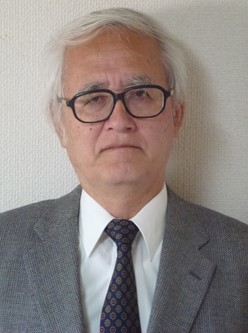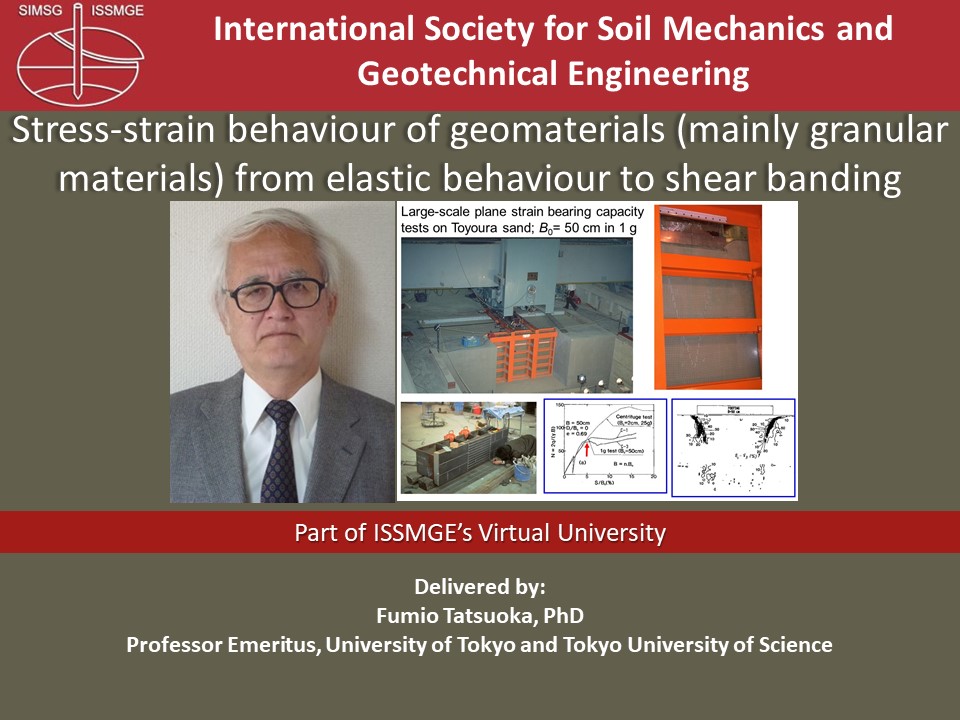
Soil Behaviour
ISSMGE

This course includes the following:
A six-video sequence on Stress-strain behaviour of geomaterials (mainly granular materials) from elastic behaviour to shear banding, by Prof. Fumio Tatsuoka (7h and 48 min)
A two-part lecture on Unsaturated Soils: Basic Concepts and Applications (Part 1 and Part 2), by Prof. Eduardo Alonso (113 min)
A lecture on Thermal Issues in Clays and Claystones. Application to Radioactive Waste Disposal, by Prof. Pierre Delage (65 min)


Eduardo Alonso

Pierre Delage
Recommended
-
![Intelligent Compaction {"category":"webinar","subjects":["Ground Improvement", "Soil Mechanics"],"number":"GI102","instructors":["Antonio Correia","George Chang"]}](/asset-v1:ISSMGE+GI102+2011+type@asset+block@pic5.jpg)
- ISSMGE
- {"category":"webinar","subjects":["Ground Improvement", "Soil Mechanics"],"number":"GI102","instructors":["Antonio Correia","George Chang"]}
- Starts:
-
![Role of the Soil-Water Characteristic Curve in Unsaturated Soil Mechanics (Geoffrey Blight Lecture - 19th ICSMGE) {"category":"honour_lecture","subjects":["Soil Mechanics"],"number":"ICSMGE19106","instructors":["Delwyn G. Fredlund"]}](/asset-v1:ISSMGE+ICSMGE19106+2017+type@asset+block@geoffrey-blight-lecture.jpg)
- ISSMGE
- {"category":"honour_lecture","subjects":["Soil Mechanics"],"number":"ICSMGE19106","instructors":["Delwyn G. Fredlund"]}
- Starts:
-
![On the Fabric and State Parameters of Active Clays for Contaminant Control (R. K. Rowe Lecture - 19th ICSMGE) {"category":"honour_lecture","subjects":["Contaminant Transport", "Soil Mechanics"],"number":"ICSMGE19114","instructors":["Mario Manassero"]}](/asset-v1:ISSMGE+ICSMGE19114+2017+type@asset+block@rowe-lecture.jpg)
- ISSMGE
- {"category":"honour_lecture","subjects":["Contaminant Transport", "Soil Mechanics"],"number":"ICSMGE19114","instructors":["Mario Manassero"]}
- Starts:
-
![Introduction to Slope Engineering {"category":"course","subjects":["Numerical and Constitutive Modelling","Soil Mechanics","Slope Stability"],"number":"GEE2020-1","instructors":["Wu Shunchuan"]}](/asset-v1:ISSMGE+SE101+2023+type@asset+block@intro-slide.jpg)
- ISSMGE
- {"category":"course","subjects":["Numerical and Constitutive Modelling","Soil Mechanics","Slope Stability"],"number":"GEE2020-1","instructors":["Wu Shunchuan"]}
- Starts:
-
![Unsaturated Soils: Basic Concepts and Applications (Part 1 and Part 2) {"category":"webinar","subjects":["Soil Mechanics"],"number":"SM101","instructors":["Eduardo Alonso"]}](/asset-v1:ISSMGE+SM101+2012+type@asset+block@pic3.jpg)
- ISSMGE
- {"category":"webinar","subjects":["Soil Mechanics"],"number":"SM101","instructors":["Eduardo Alonso"]}
- Starts:
-
![Soil Characterisation {"category":"course","subjects":["Soil Mechanics","In-situ Testing","Residual Soils","Settlements","Laboratory Testing"],"number":"VU-SC","instructors":["Cor Zwanenburg","Samuel Kofi Ampadu","Gabriel Auvinet","Serge Leroueil","Richard Jardine"]}](/asset-v1:ISSMGE+TC102-002+2017+type@asset+block@Leroueil-small.jpg)
- ISSMGE
- {"category":"course","subjects":["Soil Mechanics","In-situ Testing","Residual Soils","Settlements","Laboratory Testing"],"number":"VU-SC","instructors":["Cor Zwanenburg","Samuel Kofi Ampadu","Gabriel Auvinet","Serge Leroueil","Richard Jardine"]}
- Starts:
-
![Undergraduate teaching of Unsaturated Soil Mechanics: Building on fundamental physical mechanisms to pave the way for geotechnical analyses {"category":"talk","subjects":["Teaching Geotechnics", "Soil Mechanics"],"number":"TC306-GEE2025-05","instructors":["Alessandro Tarantino", "Alessia Amabile"]}](/asset-v1:ISSMGE+TC306-GEE2025-05+2025+type@asset+block@tarantino-amabile.png)
- ISSMGE
- {"category":"talk","subjects":["Teaching Geotechnics", "Soil Mechanics"],"number":"TC306-GEE2025-05","instructors":["Alessandro Tarantino", "Alessia Amabile"]}
- Starts:
-
![Unsaturated Soil Mechanics {"category":"course","subjects":["Soil Mechanics","Groundwater Flow & Seepage","Shear Strength of Ground Materials","Settlements"],"number":"VU-USM","instructors":["Delwyn G. Fredlund"]}](/asset-v1:Delwyn-G-Fredlund+Unsaturated-Soil-Mechanics+2019+type@asset+block@Introduction-to-Unsaturated-Soil-Mechanics.jpg)
- Delwyn-G-Fredlund
- {"category":"course","subjects":["Soil Mechanics","Groundwater Flow & Seepage","Shear Strength of Ground Materials","Settlements"],"number":"VU-USM","instructors":["Delwyn G. Fredlund"]}
- Starts:
ISSMGE Online Library Publications
-
FEM simulation of elasto-visco-plastic stress-strain behavior of stiff geo-materials
M.S.A.Siddiquee, S.J.M.Yasin, E.Hoque, F.Tatsuoka
15th International Conference on Soil Mechanics and Foundation Engineering (Istanbul) -
Récents développements de la technique osmotique de contrôle de succion
P.Delage, Y.J.Cui, E.De Laure
15th International Conference on Soil Mechanics and Foundation Engineering (Istanbul) -
Influence des mécanismes de rétention des polluants sur la résistance au cisaillement d’un sol compacté
Y.J. Cui, P.Alzoghbi, L.Lei, P.Delage
15th International Conference on Soil Mechanics and Foundation Engineering (Istanbul) -
Administrative report of TC29 - Stress-strain testing of geomaterials in the laboratory
F.Tatsuoka, S. Shibuya
15th International Conference on Soil Mechanics and Foundation Engineering (Istanbul) -
A new approach for the prediction of long term heave
E.E.Alonso, A.Lloret, A.Gens, F.Batlle
12th International Conference on Soil Mechanics and Foundation Engineering (Rio De Janeiro) -
Performance of PLPS, geosynthetic-reinforced soil structure against working and seismic loads
T.Uchimura, M.Shinoda, F.Tatsuoka, M.Tateyama
15th International Conference on Soil Mechanics and Foundation Engineering (Istanbul) -
Overconsolidation effects on secondary compression rates
E.Alonso, A.Lloret, A.Gens, M.Salvado
15th International Conference on Soil Mechanics and Foundation Engineering (Istanbul)
